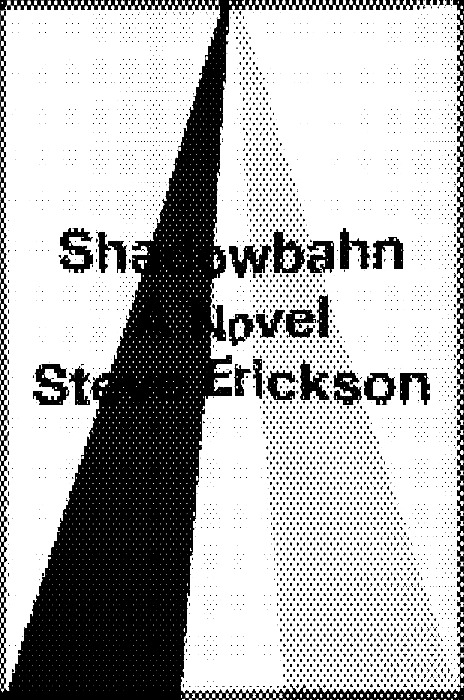
Describing Steve Erickson’s fiction is no easy task. He’s a writer who regularly wrestles with big ideas, but he’s equally at home getting under the skin of his characters, embracing their contradictions, their messiness, and their essential humanity. Among his greatest talents–and one that’s boldly on display in his 2017 novel, Shadowbahn–is his ability to explore uncomfortable moments in time, and to tap into what makes certain chapters in recent (and not-so-recent) history compelling, resonant, or discomfiting for so many of us.
All of which is to say that Shadowbahn opens with the World Trade Center re-appearing in a sparsely populated region of South Dakota a few years from now. It’s never really explained how this happens, and going too far into the mechanics of the unreal in an Erickson novel tends to miss the point. In Erickson’s fiction, timelines bifurcate; characters wake up in unfamiliar places and situations; and a kind of dream logic is paramount. (He’s also in the small category of writers who have been blurbed by Thomas Pynchon.) Even in his most nominally realistic novel, Zeroville–about an eccentric figure who wanders out of an isolated, almost monastic life and helps usher in an aesthetic revolution in 1970s Hollywood–there are surreal touches to be found.
With Erickson, it’s more that nearly anything and everything from American history seems fair game to him: the World Trade Center also makes a memorable appearance in 2005’s Our Ecstatic Days, for one thing. 1989’s Tours of the Black Clock explores the way that complicity with fascism can come easily to many of us. And Sally Hemings is one of the central characters in 1993’s Arc d’X. Erickson is an author for whom national tragedies are things with which to wrestle from an unexpected angle–and the results are almost always searing, haunting, and immeasurably powerful.
To call Erickson’s work transgressive is also not entirely accurate, at least in the sense that that label can be applied to writers like Kathy Acker or Dennis Cooper. For all that he’s exploring larger historical and societal themes in uncomfortable ways, Erickson’s method of disorienting the reader can be subtle. It also works on a number of levels: Erickson himself turns up as a character in Arc d’X, but his fictional analogue meets a terrible and violent end. And Zan Nordhoc, the protagonist of 2012’s These Dreams of You, reads at times like a stand-in for the author as well: Leah Hager Cohen’s review of it for The New York Times notes several of the ways in which this is the case. But Zan isn’t always the most sympathetic of figures; here, too, his role in the book seems less a case of authorial insertion and more one of haunting ambivalence.
Erickson’s fiction has always engaged with contemporary concerns to some extent. The fall of the Berlin Wall and the then-coming millennium both factored into Arc d’X, for instance, and environmental catastrophes bedevil the California settings of both Rubicon Beach and Days Between Stations. Beginning with These Dreams of You, Erickson has engaged more directly with contemporary issues: the 2008 financial crisis and the election of Barack Obama both play a role in the novel, as does the question of being an outsider in a nation that seems increasingly hostile to outsiders in a variety of ways.
Shadowbahn shares that concern with its immediate predecessor–besides the constant allusions to the national trauma of September 11, 2001, Erickson also grapples with questions of racism and nationalism over the course of the book. A couple of the characters from These Dreams of You turn up in Shadowbahn as well–though given its near-future setting, they’ve aged a bit since the last time readers encountered them. And the America through which they move is also altered: references to “Disunion” in the text suggest that a secessionist movement has taken hold of parts of the country in recent years. This aspect of the plot never becomes overwhelming–though Erickson is fond of speculative elements in his work, the mechanics of them feel less essential.
What Erickson is ultimately after here is a question of how the nation deals with trauma–and, to an extent, whether the direction it took after 2001 is a fundamentally unsustainable one. There are moments of boldness and wonder in Shadowbahn: miracles, reversals, and revelations punctuate its pages, counterpointing a weary sense of resignation that accumulates over the course of the book. There are aspects of Shadowbahn that feel somewhat valedictory: the references to Erickson’s past work, a subplot in which American history follows two distinct timelines (echoes of Tours of the Black Clock), and the evocation of a prominent figure from the history of the 20th century–in this case, Elvis Presley, whose stillborn twin Jesse figures prominently in one subplot.
Shadowbahn exists at a far remove from what we might consider a realistic novel to be; at the same time, Shadowbahn also has plenty to say about the world (and the nation) in which we live, and does so far more resoundingly through its departures from the more grounded. In going to places few other writers might touch, Erickson explores uncomfortable questions towards a greater moment of revelation. Like These Dreams Of You’s Zan, Erickson is broadcasting unexpected messages with a powerful urgency. The song itself might be initially jarring, but it soon becomes familiar; it soon explains why it’s there.
This essay originally appeared at Read It Forward.
Follow Vol. 1 Brooklyn on Twitter, Facebook, and sign up for our mailing list.
